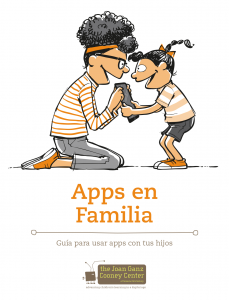
En diciembre del año pasado publicamos Family Time with Apps, un libro electrónico diseñado para ayudar a los padres a comprender mejor cómo las “apps” móviles (aplicaciones para teléfonos y tabletas) pueden apoyar el desarrollo saludable de los niños, como el aprendizaje, la comunicación y las conexiones en familia. Esa guía tiene como objetivo mostrarles a los padres cómo encontrar las mejores aplicaciones para las necesidades de sus hijos, proporcionar consejos sobre cómo (y por qué) usar las aplicaciones juntos y sugerir recursos que hagan el proceso de elegirlas más fácil y más divertido.
Una parte importante de la misión del Joan Ganz Cooney Center es difundir información basada en la investigación científica. Cuando lanzamos Family Time with Apps, recibimos buenas reacciones y también muchas solicitudes de los bibliotecarios y los líderes comunitários que nos preguntaban si existía una versión en español. Con mucho gusto anunciamos que Apps en Familia ya está disponible. El libro está disponible en dos formatos, los dos totalmente gratuitos:
-
como “ibook” (libro interactivo) a través de la aplicación iBooks en su computadora, iPad o iPhone con los últimos iOS.
-
una versión PDF que funciona en cualquier computadora o dispositivo móvil.
Esperamos tu opinión sobre este recurso gratuito, que se puede descargar aquí. Por favor compártelo con tus amigos, colegas y organizaciones comunitarias a quienes pueda interesar.